How to Create Accessible LibreOffice files
TDF LibreOffice Document Liberation Project Community Blogs Weblate Nextcloud Redmine Ask LibreOffice Donate
How to Create Accessible LibreOffice PDFs and documents
Creating accessible content using LibreOffice not only helps people with disabilities access, navigate and understand your content, but there are many benefits for everyone else too.
Good accessibility means better use of your content in many other technologies, assistive or otherwise. This page outlines a list of actions that accumulatively contribute to accessibility.
How to run the LibreOffice Accessibility Checker
Running the Accessibility Checker (PC and Mac)
You can use Accessibility Checker in Writer to ensure the content is truly accessible. It finds potential accessibility issues and prompts to help resolve each issue. The Accessibility Checker can be run whenever you like.
- Open the original in LibreOffice Writer.
- Click Tools from the menu and select Accessibility Check....
- Follow the prompts in the Accessibility Check sidebar to fix issues.
Checking accessibility while you work
Tips displayed in the Accessibility Check sidebar are dynamic - updating with tips if needed whilst you edit the document.
How to save a tagged PDF
Saving a tagged PDF using LibreOffice (PC and Mac)
- Open the original in LibreOffice
- Click File from the menu and select Export as PDF.
- In the PDF Options dialog box, make sure the Tagged PDF (add document structure) and the Export bookmarks boxes are selected.
- Click Export.
How to add headings
Adding headings in LibreOffice Writer (PC and Mac)
Turning text into headings.
- Open the original in LibreOffice Writer.
- Select the text that should become a heading.
- In the Formatting bar, open the Apply Paragraph Style dropdown and select the appropriate heading level. If you don’t see the heading level you are looking for, click More options.
- Repeat this for all the text that should become headings.
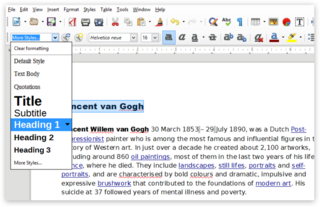
Screen capture of the Paragraph Style dropdown menu in LibreOffice on a PC
Styling headings in LibreOffice Writer
Customizing the visual appearance of a heading style.
- Open the Apply Paragraph Style dropdown. Click the arrow next to the heading style of which you want to change the visual appearance.
- Click Edit Style from the menu.
- Make any formatting changes that you would like to make (e.g. Font, font size, etc) in the Font and Font Effects tabs and click OK. All text which has that heading applied will automatically be updated.
- Save the document.
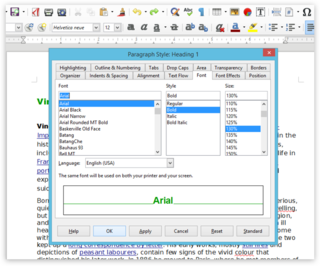
Screen capture of the Paragraph Style dropdown menu in LibreOffice on a PC
Adding titles in LibreOffice Impress (PC)
- Open the original in LibreOffice Impress.
- Click the first slide which contains a title.
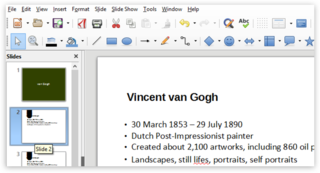
Screen capture of a LibreOffice Impress file on a PC - Open the Properties menu on the right side. Open the Layouts section. As your slide contains a title, choose one of the layouts that best fit the structure of your slide.
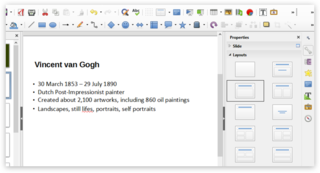
Screen capture of Layouts in LibreOffice Impress on a PC - If the already existing title and content show up nicely within the provided title and content boxes, it means the slide uses the layout correctly.
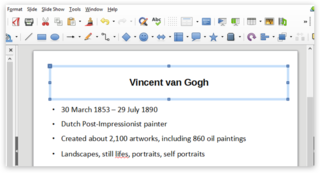
Screen capture of a Title in LibreOffice Impress on a PC - If an empty title and text box show up on top of the already existing text boxes, it means the title and text have to be transferred to these boxes. Transfer the text for the title to the title box, and content to the content boxes.
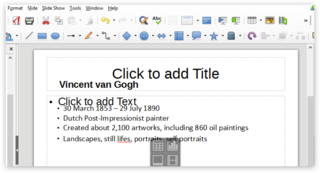
Screen capture of Layouts being applied in LibreOffice Impress on a PC - Repeat these steps for all the slides that appear to have titles and save the document.
Adding titles in LibreOffice Impress (Mac)
- Open the original in LibreOffice Impress.
- Click the first slide which contains a title.

Screen capture of a LibreOffice Impress file on a Mac - Open the Properties menu on the right side. Open the Layouts section. As your slide contains a title, choose one of the layouts that best fit the structure of your slide.
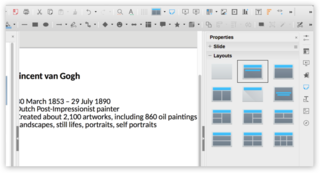
Screen capture of Layouts in LibreOffice Impress on a Mac - If the already existing title and content show up nicely within the provided title and content boxes, it means the slide uses the layout correctly.
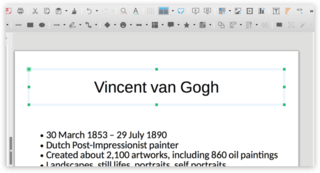
Screen capture of a Title in LibreOffice Impress on a Mac - If an empty title and text box show up on top of the already existing text boxes, it means the title and text have to be transferred to these boxes. Transfer the text for the title to the title box, and content to the content boxes.
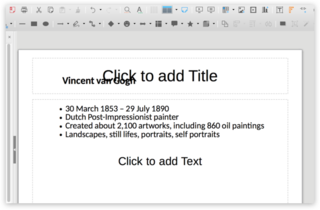
Screen capture of Layouts being applied in LibreOffice Impress on a Mac - Repeat these steps for all the slides that appear to have titles and save the document.
How to add alternative descriptions to images in a document
Alternative descriptions are also known as Alternative Text or (alt text). Screen readers speak the text, which describes the non-text content that the user may not be able to see.
Adding an image description in LibreOffice Writer (PC)
- Open the original in LibreOffice Writer.
- Double click the image. The Image dialog box shows up.
- Click the Options tab in the Image dialog box.
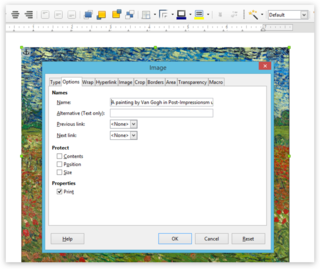
Screen capture of an image's options in LibreOffice Writer on a PC - Enter a brief description for the image in the Name field.
Adding an image description in LibreOffice Writer (Mac)
- Open the original in LibreOffice Writer.
- Double click the image. The Image dialog box shows up.
- Click the Options tab in the Image dialog box.
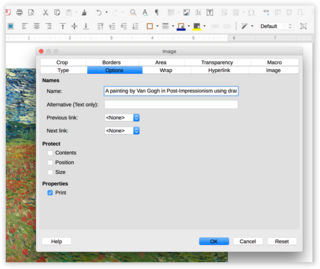
Screen capture of an image's options in LibreOffice Writer on a Mac - Enter a brief description for the image in the Name field.
Adding an image description in LibreOffice Impress (PC)
- Open the original in LibreOffice Impress
- Select the image. Click Format in the menu bar and select Description from the list. The Description panel shows up.
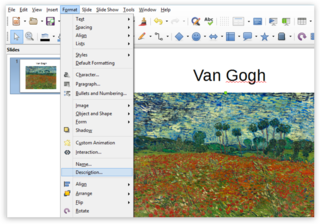
Screen capture of an image's options in LibreOffice Impress on a PC - Enter a brief description for the image in the Description box. If the description is long, a summarized Title should also be provided.
- Click OK to save your changes.
- Repeat these steps for all images in the document. Save the document.
Adding an image description in LibreOffice Impress (Mac)
- Open the original in LibreOffice Impress
- Select the image. Click Format in the menu bar and select Description from the list. The Description panel shows up.
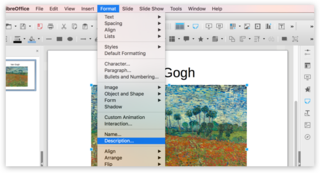
Screen capture of an image's options in LibreOffice Impress on a Mac - Enter a brief description for the image in the Description box. If the description is long, a summarized Title should also be provided.
- Click OK to save your changes.
- Repeat these steps for all images in the document. Save the document.
How to add headers to a table
Adding headers to a table in LibreOffice Writer (PC)
- Open the original in LibreOffice Writer.
- Ensure the text in the first row functions as a title and identifies what each column is for. E.g: Week, Topic, Date and so on.
- Right-click the table and select Table Properties. Or, select Table Properties from the bottom or top menu. The Table Format dialog box shows up.
- In the Table Format dialog box, select the Text Flow tab. Make sure the Repeat heading check box is selected and that at least the first row is filled out.
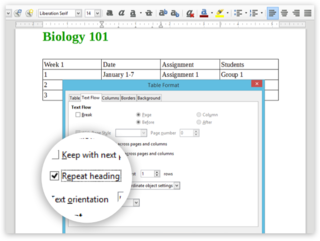
Screen capture of Table Format options in LibreOffice Writer on a PC - Repeat these steps for tables in the document. Save the document.
Adding headers to a table in LibreOffice Writer (Mac)
- Open the original in LibreOffice Writer.
- Ensure the text in the first row functions as a title and identifies what each column is for. E.g: Week, Topic, Date and so on.
- Right-click the table and select Table Properties. Or, select Table Properties from the bottom or top menu. The Table Format dialog box shows up.
- In the Table Format dialog box, select the Text Flow tab. Make sure the Repeat heading check box is selected and that at least the first row is filled out.
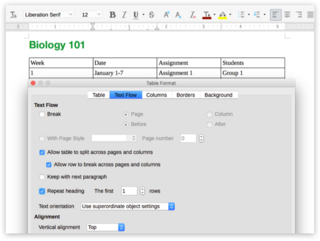
Screen capture of Table Format options in LibreOffice Writer on a Mac - Repeat these steps for tables in the document. Save the document.
Adding headers to a table in LibreOffice Impress (PC)
- Open the original in LibreOffice Writer.
- Ensure the text in the first row functions as a title and identifies what each column is for. E.g: Week, Topic, Date and so on.
- Right-click the table and select Table Properties. Or, select Table Properties from the bottom or top menu. The Table Format dialog box shows up.
- In the Table Format dialog box, select the Text Flow tab. Make sure the Repeat heading check box is selected and that at least the first row is filled out.
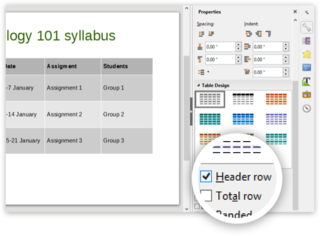
Screen capture of Table Design options highlighting the "Header row" option in LibreOffice Impress on a PC - Repeat these steps for tables in the document. Save the document.
Adding headers to a table in LibreOffice Impress (Mac)
- Open the original in LibreOffice Writer.
- Ensure the text in the first row functions as a title and identifies what each column is for. E.g: Week, Topic, Date and so on.
- Right-click the table and select Table Properties. Or, select Table Properties from the bottom or top menu. The Table Format dialog box shows up.
- In the Table Format dialog box, select the Text Flow tab. Make sure the Repeat heading check box is selected and that at least the first row is filled out.
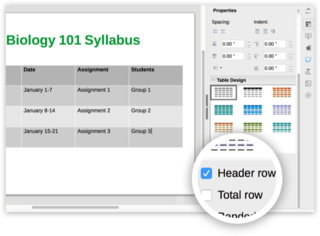
Screen capture of Table Design options highlighting the "Header row" option in LibreOffice Impress on a Mac - Repeat these steps for tables in the document. Save the document.
Accessible Lists
To make it easier for screen readers to read your document, organize the information in your document into small chunks with bullets or numbered lists.
- Avoid adding a plain paragraph in the middle of a list as this can confuse screen readers.
How to set a language
Setting the document language in LibreOffice Writer (PC)
- Open the original in LibreOffice Writer.
- Determine the main language of the text. When a lot of text is underlined with red squiggly lines, this is often an indication that the language isn’t set correctly.
- Set the correct document language by clicking on Tools > Language > For all Text > More…. The Options - Language Settings - Languages dialog box shows up.

Screen capture of the "Tools" menu highlighting "Language" in LibreOffice Writer on a PC - Under Default Languages for Documents, select the correct document language from the dropdown. If you check For the current document only, your choice will only apply to the current document.
- Click OK and save the document.
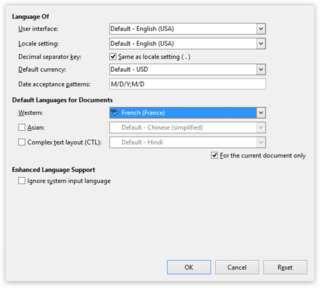
Screen capture of the "Language" options modal in LibreOffice Writer on a PC
Setting the document language in LibreOffice Impress (PC)
- Open the original in LibreOffice Impress.
- Determine the main language of the text. When a lot of text is underlined with red squiggly lines, this is often an indication that the language isn’t set correctly.
- Set the correct document language by clicking on Tools > Language > For all Text > More…. The Options - Language Settings - Languages dialog box shows up.
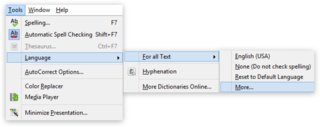
Screen capture of the "Tools" menu highlighting "Language" in LibreOffice Impress on a PC - Under Default Languages for Documents, select the correct document language from the dropdown. If you check For the current document only, your choice will only apply to the current document.
- Click OK and save the document.
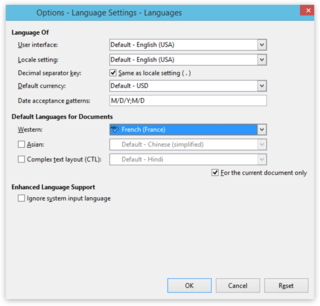
Screen capture of the "Language" options modal in LibreOffice Impress on a PC
Setting the document language in LibreOffice Writer (Mac)
- Open the original in LibreOffice Writer.
- Determine the main language of the text. When a lot of text is underlined with red squiggly lines, this is often an indication that the language isn’t set correctly.
- Set the correct document language by clicking on Tools > Language > For all Text > More…. The Options - Language Settings - Languages dialog box shows up.
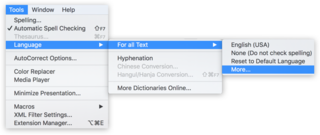
Screen capture of the "Tools" menu highlighting "Language" in LibreOffice Writer on a Mac - Under Default Languages for Documents, select the correct document language from the dropdown. If you check For the current document only, your choice will only apply to the current document.
- Click OK and save the document.
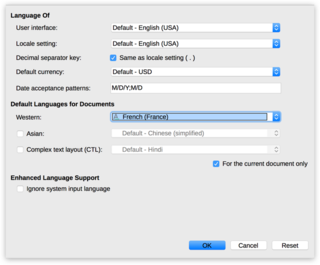
Screen capture of the "Language" options modal in LibreOffice Writer on a Mac
Setting the document language in LibreOffice Impress (Mac)
- Click on the View tab and select Outline. Select the text from all the slides that need changing.
- Right-click and choose Character… from the menu. The Character dialog box shows up.
- On the Fonts tab, select the correct language for the selected text and click OK.
- Repeat these steps for all the text that needs changing.
- Save the document.

Screen capture of the "Language" options modal in LibreOffice Impress on a Mac
Choosing a language for selected text in LibreOffice Writer (PC)
Text that is still underlined with red squiggly lines or paragraphs in a different language need their language set separately.
- Select all the text in specific text boxes that need changing.
- Right-click the selected text, and choose Character… from the menu. The Character dialog box shows up.
- On the Font tab, select the correct language for the selected text and click OK.
- Repeat these steps for all the text that needs changing.
- Save the document.
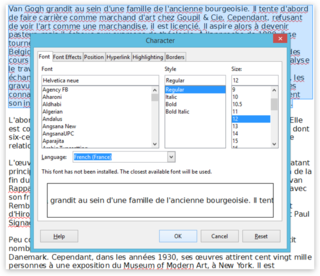
Screen capture of the "Character" options modal in LibreOffice Writer on a PC
Choosing a language for selected text in LibreOffice Impress (PC)
Text that is still underlined with red squiggly lines or paragraphs in a different language need their language set separately.
- Select all the text in specific text boxes that need changing.
- Right-click the selected text, and choose Character… from the menu. The Character dialog box shows up.
- On the Fonts tab, select the correct language for the selected text and click OK.
- Repeat these steps for all the text that needs changing.
- Save the document.
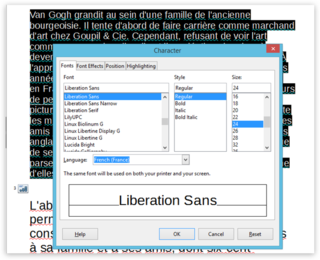
Screen capture of the "Character" options modal in LibreOffice Impress on a PC
Choosing a language for selected text in LibreOffice Writer (Mac)
Text that is still underlined with red squiggly lines or paragraphs in a different language need their language set separately.
- Click on the View tab and select Outline. Select the text from all the slides that need changing.
- Right-click and choose Character… from the menu. The Character dialog box shows up.
- On the Font tab, select the correct language for the selected text and click OK.
- Repeat these steps for all the text that needs changing.
- Save the document.

Screen capture of the "Character" options modal in LibreOffice Writer on a Mac
Choosing a language for selected text in LibreOffice Impress (Mac)
Text that is still underlined with red squiggly lines or paragraphs in a different language need their language set separately.
- Select all the text in specific text boxes that need changing.
- Right-click the selected text, and choose Character… from the menu. The Character dialog box shows up.
- On the Fonts tab, select the correct language for the selected text and click OK.
- Repeat these steps for all the text that needs changing.
- Save the document.
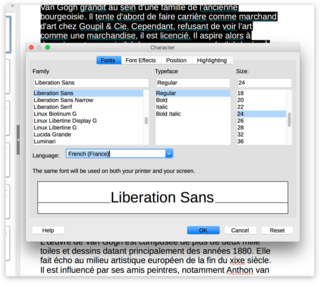
Screen capture of the "Character" options modal in LibreOffice Impress on a Mac
Add accessible hyperlink text
Screen readers may scan links, so ensure links have accurate information about the destination by using link texts with the full title of the destination page.
Accessible Tables
If possible, avoid tables and show the data another way, if tables are needed, keep them simple and for data only.
- Specify column header information, also identify the header row with the repeat heading option. As this can be read by the screen reader to help the user understand the tables contents. It also helps describe to the user where the cursor is located in the table, so the user can navigate the table.
- If hyperlinks are used in a table, edit the hyperlinks texts so they do not break mid-sentence.
- Test tables display OK on other devices such as smartphones and tablets.
- Avoid fixed width tables.
- Avoid split cells, merged cells, or nested tables, these can confuse screen readers.
- Avoid completely blank rows or columns, as a screen reader can mislead the user into thinking it is the end of the table's content.
How to adjust spacing between sentences, lines and paragraphs
Adding extra spacing between sentences, lines and paragraphs
Dyslexia makes it hard to see text on a page, it is sometimes described as text overlapping as it is being looked at. Increasing the spacing between sentences, lines and paragraphs can help, this can be done by adjusting the document's indents and spacing.
- Open the original in LibreOffice.
- Click Format from the menu and select Paragraph.
- Adjust the options on the Indents & Spacing tab.
Accessible font styles
- Choose a font that makes reading a document easier, think of people with low vision, dyslexia and other disabilities.
- Avoid using all capital letters and other excessive font styling.
- Avoid using colours to convey a meaning, some people might miss the meaning due to colour blindness. Instead:
- Use bold or a larger font.
- Hyperlinks should be underlined so that people with colour blindness know that the text is linked even if they can’t see the colour.
Good contrast and colours to avoid
- Have a good contrast between colours of the text and the background to make the text is easy to see. This helps people with low vision.
- Avoid light blue colours, as this colour is often the first colour that people start to struggle to see when they age.
Paragraph banners
Add paragraph banners, which can help people who are visually impaired and/or have dyslexia. Make the background colour block extend across the width of the document, you could highlight the text within the banner.
- Format > Paragraph > Area tab > Colour > choose a colour (avoid the colour light blue).
Screen readers do not always scan and read Header or Footer sections of documents, as these areas are not always visible in some office suites. Avoid having content that is only in the Header or Footer when it is important to the user.
How to test Accessibility with a Reader
With a free reader you can test reading the document out aloud to get an idea for how to optimise the document if needed. A free and open source multiplatform document viewer called Okular claims to be able to read PDFs and OpenDocument files aloud.